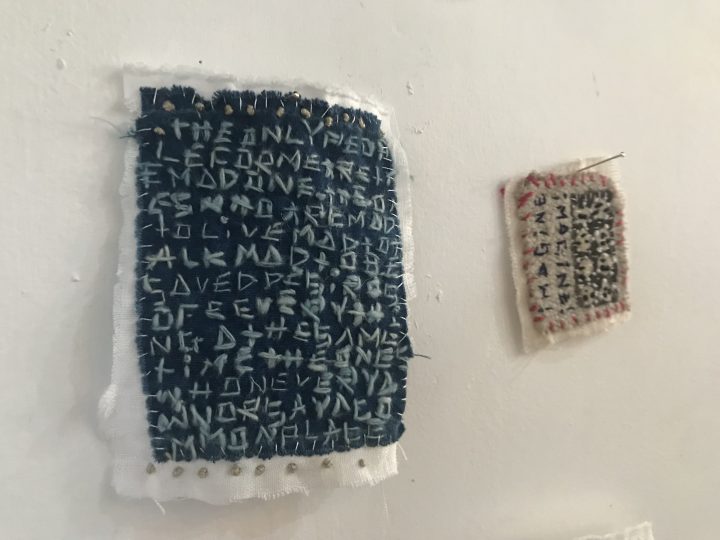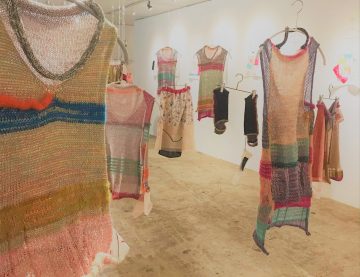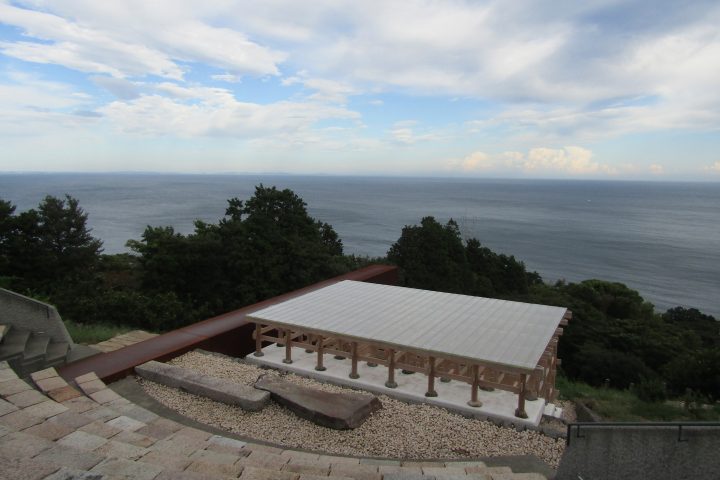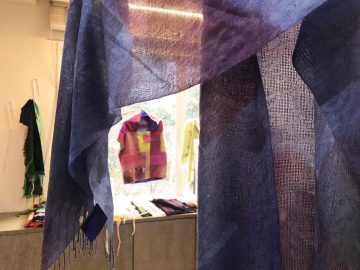Interview with Gregor Schneider
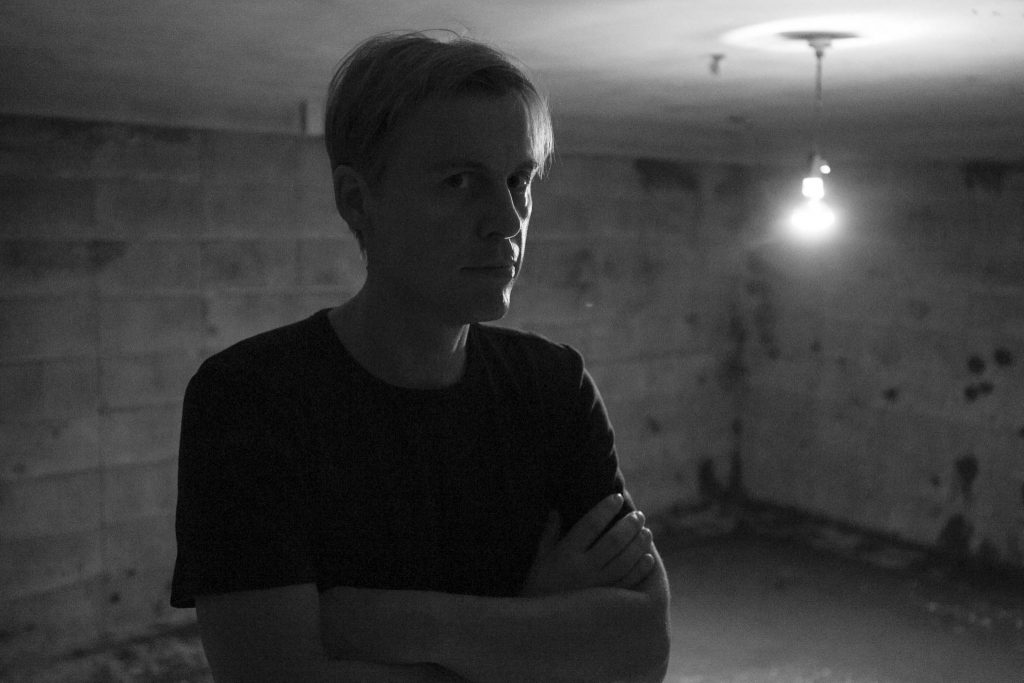
Interview: Haruo Kobayashi Text: Akiko Inoue Photo: Masanobu Nishino
Yokohama Triennale 2014 has been crowded with visitors since its opening on August 1. In the parking lot of the venue appears an unusual space.:《GERMAN ANGST》. It is the new work of German artist Gregor Schneider (born 5 April 1969, in Rheydt) which he made on his first visit to the City of Yokohama.Schneider started creating artwork at the age of 12, and had his first solo exhibition when he was 16.In 2001, he was awarded the Golden Lion at the 49th Venice Biennale (for his work Totes Haus ur showing at the German Pavilion).His works often remind the viewers the color black , which is associated with “death”, “darkness” or “shadow” .It should be noted that his unique way of creating spaces and specific persistence to invisibles characterizing his works.
MAGCUL.NET met with Schneider while he was in Yokohama working on the exhibition, to talk about one of his masterpieces <<Haus ur 1985-today>> (※1) , which is still in progress, and likely to develop during the artist's lifetime, and to also discuss the ideas and inspirations for the new work as well as other works that have been presented at various venues all over the world. Following is his interview with Haruo Kobayashi, artist/director of an alternative artspace blanClass in Yokohama.
― This is the first time that I get to see your work. I saw and read about your works on various websites and other sources, and I have just seen your brand-new work on the underground. I would like to ask you about several points including your experience with your new work for the Triennale.
Born in a coal-mining town
― First of all, I am about the same age as you. Though our cultural backgrounds are different, I did feel some sort of sympathy for your approach to “rooms”. I imagine that the period you have been through has something to do with your attitude towards rooms. What do you think?
Certainly, the fact I have been brought up in a coal-mining town Rheydt, Germany, does have influence on me. There were a lot of unemployed people there. And there were houses that were empty…the whole town was for me like an atelier, a place to work on creating things. It was how my first artwork 《Haus ur 1985-today》was born, from an environment and atmosphere that are kind of similar to Detroit, in the US.
In the past 90 per cent from the city Rheydt were destroyed after world war. But there has been a lot of people in and out, and the area has been continuously changing. There they dug in the ground with a huge machine, sometimes they destroyed a village and created a whole new place there. They dug in the ground with a huge machine, sometimes they destroyed a village and created a whole new place there. The coal mining destroyed more than any war before.
My family is the 5th generation to own a lead factory, and there were several buildings that were no longer in use. But he could not just get rid of those buildings, so they remained there. That's how I started to construct 《HAUS ur》 . It is common to everyone… I mean, you start doing something after being triggered by certain causes that have to do with your environment.
― To me, rooms of a house, in cities or in town, are built to divide something from other things.But what you have been doing is constructing nested structures, layering walls on walls, creating another divided room inside a room… Could you tell us about this approach of yours to those rooms?
For me, the most important technique is to build a replica of a room inside or next to the existing room. I build a bedroom in a bedroom, a kitchen in a kitchen, a children's room in a children's room... I have been doing this until today.

Now let's take a look at some rooms of the 《HAUS ur》.
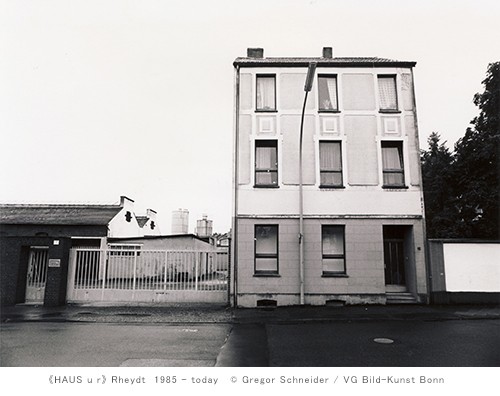
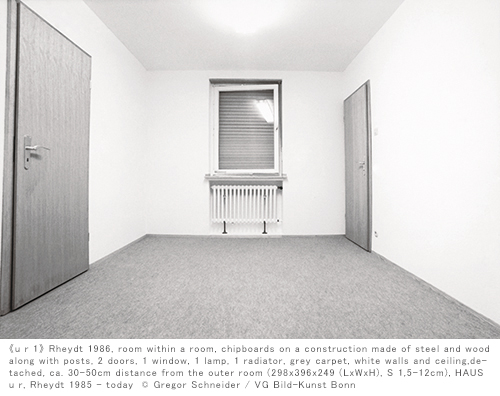
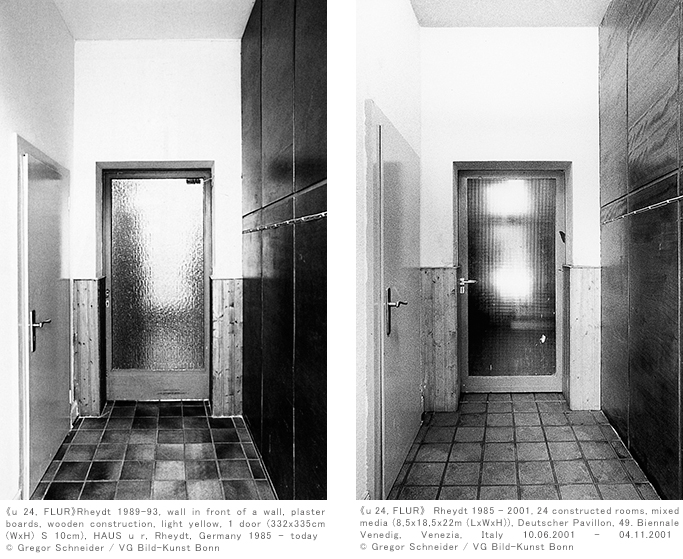
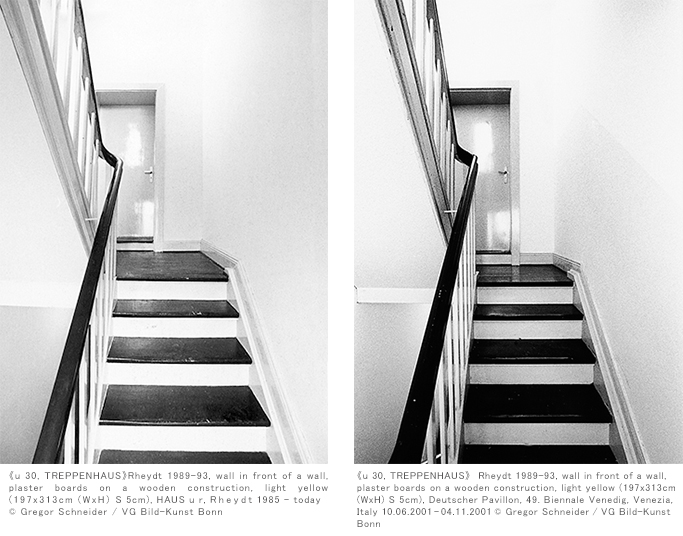
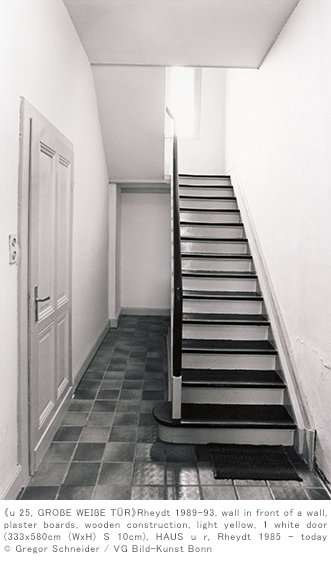
These are not architectural spaces, but are facsimiles of rooms-within-rooms in the existing house, created as artworks. For me the most important thing is to create a complete replica inside the existing room. I don't just split the rooms, but I duplicate all the rooms, including walls, floors, ceilings. So those rooms are like an onion. You peel away skins of an onion, then you find another layer of skins. And, visitors don't have to acknowledge that.
― That means, the rooms are standing on their own, and exist on a conceptual level?
It depends on each work. The rooms I create can be used, and function in a real-life situation. When I make replicas, I duplicate both the form and the function. At 《HAUS ur》 you have running water and bedrooms where you can stay overnight. You can actually live there.
And there is a room called 《KAFFEEZIMMER》=TURNING COFFEE ROOM. This room has an invisible rotating mechanism built into it, and it makes one revolution while visitors sit down and have a cup of coffee. But the room rotates so slowly that when they leave the room, they don't notice that they rotated once right round.

Another work, for example, has a ceiling that rises and falls 5cm unnoticeably slowly (taking 45 minutes).
The most important concept for me is, to construct a room inside a room, and to repeatedly construct replicas inside an existing one. Then, from inside, you can't see the original room anymore, since it is like being covered by the layer of an onion. And you don't think about a room anymore.
― That feeling of “peeling an onion” – are you saying that it occurs inside the visitor's head?
Well, I can't tell because everyone has different feelings.《HAUS ur》seems to be just a normal house when you look at it from outside. So it happened that one day, a man came to sell me insurance. I had a visitor who knew nothing about my work, and I had coffee and cake with her. She left without noticing anything. But actually they were spending time in that room surrounded by artworks.
The same thing can be said about myself. I lived in insulated rooms of 《HAUS ur》and lived an ordinary life. Meanwhile, I kept on reconstructing, making changes to the rooms. Finally I myself didn't know anymore what the original room was like. For example, I build a black stone, a red stone, a blue stone into a wall. The next day, you don't know anymore where you put that stone because there is a wall in front of a wall. situation, the surrounding is just too complicated, you see.
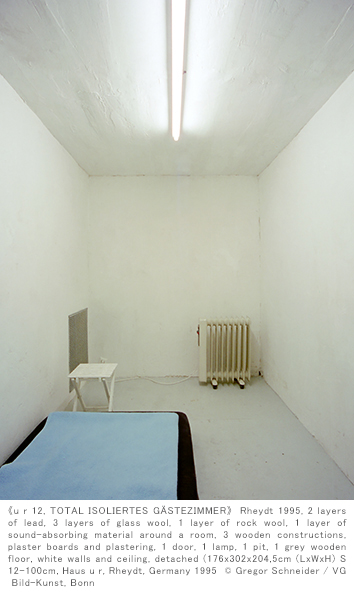
Visible / invisible, recognizable / non-recognizable
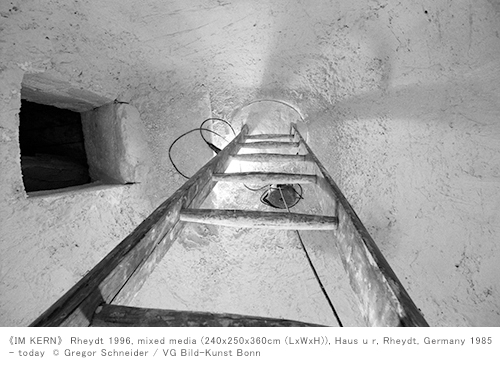
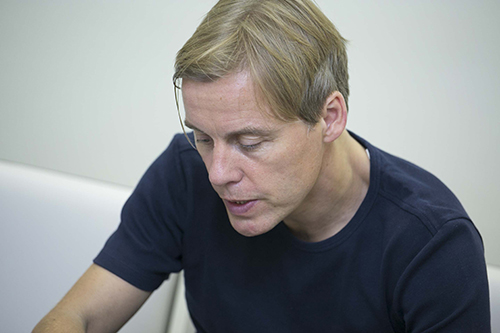
For instance, there is a ladder behind this room. But it is not visible. You have put it there by yourself, but you can't see it anymore.
― Even if the room doesn't get recognized as a work of art, there must be something with which you are trying to reach the visitors. What is it?
Well, the question here is, visible / invisible, recognizable / non-recognizable. A room built inside a room is visible, but non-recognizable. That means, you “see” it as a normal room, but don't “recognize ” it as an artwork. So there exists a gap. My works are very much complicated. Situations differ for each visitor, and each visitor has his/her own idea about rooms. I can only say that visitors will be led to walk around inside my works, asking themselves, “is this any kind of artwork anymore?” In the end, there is no more question about art! Difference between life and art doesn't exist any more.
― How do you perceive “rooms” as artworks?
For example, when you look at the paintings, you stand in front of the piece. Or when you look at the sculptures, you walk around them. But when you go inside the rooms, you are surrounded by the built room, there is always something behind you that you can't see with your own eyes. That is the difference.Also, if you build a room inside a room, there will be a shadow between the walls of the original room and the new room. And the narrower the space between the walls, the darker those shadows between the walls become. I have been working on this, duplicating, multiplying walls and rooms, from the start of working on the《HAUS ur》in 1985.
And for Venice Biennale 2001 (※2) , I have demolished some parts of the《HAUS ur》that I made in my hometown Rheydt, and moved it to another place, Venice, for reconstruction.
―I have so far understood your basic ideas about visible/invisible, recognizable/non-recognizable, and how your works affect the visitors. Now my question is: Does each of your works imply different things?
My first building work《HAUS ur》 began with very personal action, me actually living in that house. But it seems that since Venice Biennale, my works have begun to contain also social and political aspects.
Death
― How do you perceive “death”?
I see it as a scientific matter.
There is a work called 《TOTER RAUM(=DEAD SPACE)》. “Tot” means “death” in German. Here the German title contains a meaning of “hidden space” as an architectural term. So it means the space is “non -accessible”, “no-exit” or “dead-end”.
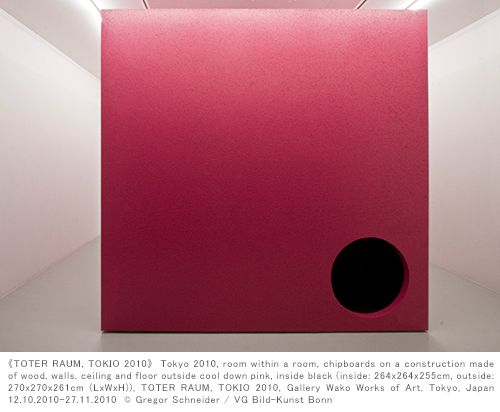
I have constructed a “dead space”, just like constructing a bed room, a kitchen or a bathroom. For me, a “dead space” is not a special room, but a room that exists just like other rooms.
What I am trying to say is, that there is nothing that divides a life and an artwork. You can live in a room, and you can die in that room, too. Dying is the final process of life, and it's a part of living. For me, dying is a sculptural process, and it is a challenge that each one of us has to face in a lifetime.
― So do you see your artwork as your own world?
No, not exactly as a world. My work is a constructed work, it is three-dimensional, and concrete. For me an artwork doesn't exist if it is not constructed. So it is not a “world”, but it is something that I have worked on and constructed. Otherwise, I wouldn't call it an artwork.
Construction is a way of getting close to the unknown
I have built a room called 《WHITE TORTURE ROOM》.
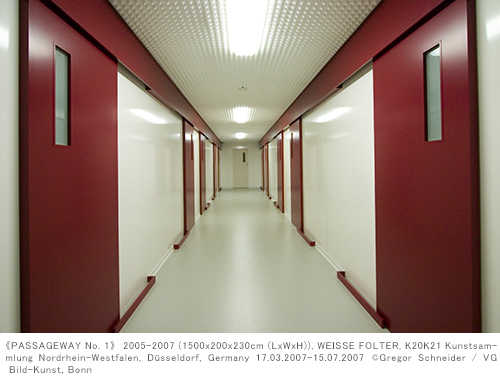
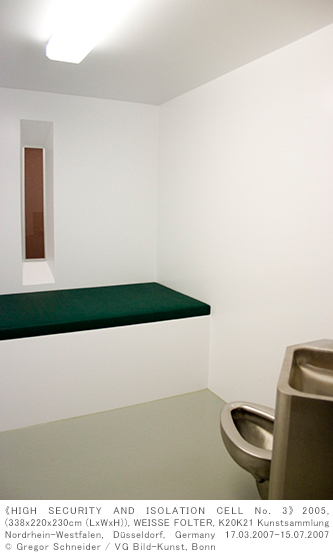
I have created this room based on images from the secret US prison camp 5 in Guantanamo Bay (※3) . Since there is no way of entering the actual prison for due to strict security measures , I have collected information from the internet. I have been trying to create things that I don't understand or rooms I can't go inside.
By doing this, I get to know how it was made. And when I make something for the second time, it becomes clear why I did what I did when I made it for the first time.
You can see photos of prisons of Guantanamo, but you can't go in there. So, the only way that I get close to it as a sculptor is to construct a replica, based on the information I have.
― What does constructing mean to you? Is it the same as thinking?
For me, constructing is one of the methods through which I accomplish my own self. It is also a process of understanding things. I created a work 《CUBE》inspired by the building (※4) in the Kaaba (※5) . Through this experience, I could have a physical experience of standing in front of the black stone. This is how I approach things that are totally unknown and un-comprehensible. In this case, the doubling let the visitors reflect.
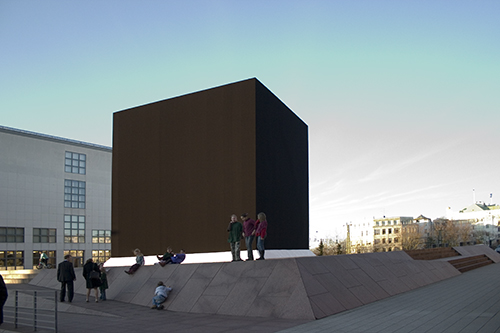
― Why are you making installations of hidden places? And why do you make things that you exhibit invisible? Are you doing this because it is impossible to make everything visible to everyone anyway?
Well, I can't answer that question in general, because each work is different. For me the work exists there as is. That's all.
Installation for Yokohama Triennale 2014
― Having just seen your installation down in the underground parking lot, I thought that your work gives us a sense of a more “closed” feeling than your prior works.
Well, also for me, the work is different than my works before, it's new this time.
According to the Artistic Director of Yokohama Triennale 2014, Yasumasa Morimura, the main theme of this Yokohama Triennale is “oblivion”. Is there anything in your work in the basement that relates to the word “oblivion”?
I don't know if my work in the basement has something to do with “oblivion”, because my work this time is also completely new for me. Besides, like always, the work absorbed by itself. Since starting off to create something is always an instinctive process, there are a lot of things that I myself don't understand. In other words, I am doing things that are unknown to me. For me it is also interesting that I am here in Yokohama, creating again something abstract.
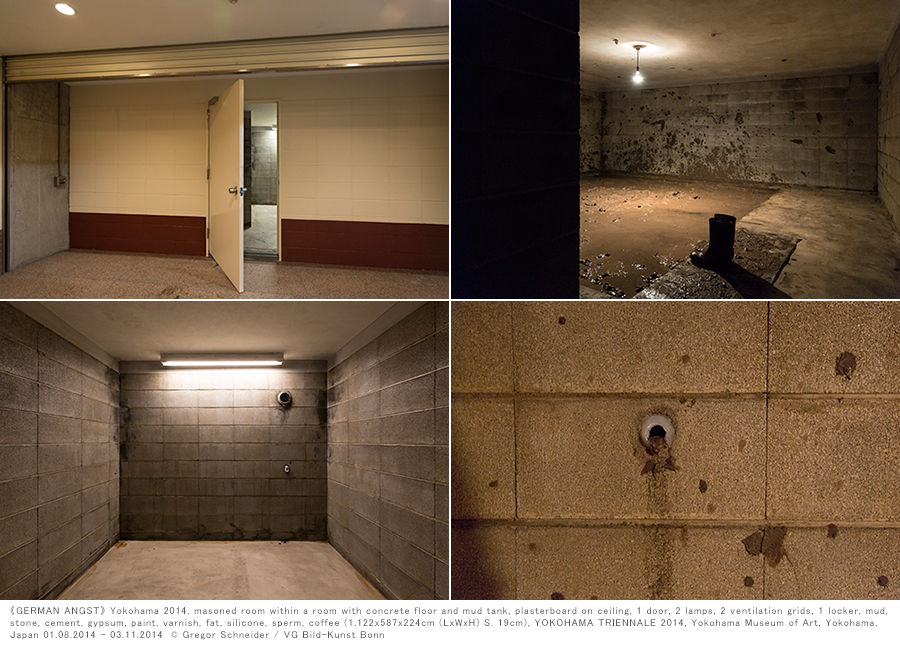
I have made a space you can enter 24 hours a day, with a special entrance made for that space apart from the regular entrance. It is very difficult to create spaces like this since general museums are made to exhibit paintings or photos. But it's also interesting for me to experience the conflict arise in the process of realizing that kind of project.
As for the installation this time, I think it will be an interesting experience for the visitors to go and see the installation, dark and filled with mud, in the underground parking lot in a part of a museum space – a white cube for exhibition, and to be able to go into the mud and walk.

Notes
*1 In 1985 he began dismantling and rebuilding rooms in an apartment building that his parents owned in Rheydt, while he actually lived in that house.
*2 Gregor Schneider won the first prize (“Golden Lion”) at the 49th Biennale in Venice.
*3 United States Army's prison camp located on south-east of Cuba, at Guantánamo Bay. Under President Bush, Since January 2002, it has been used as a camp for suspected terrorists, and taking in those who were arrested in Afghanistan or Iraq. Known for atrocious acts of torture, it has become an international human rights issue.
*4 the ancient stone building toward which Muslims pray from all over the world.
*5 Islam's most sacred mosque in Mecca
Translation: Kie Ichimura
